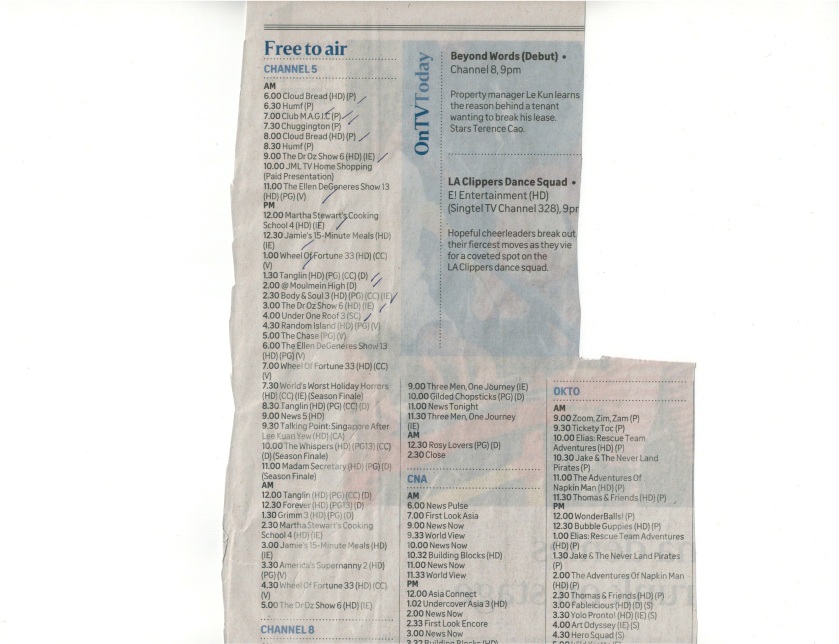Children love stories. Here is one I wrote for the topic of Patterns:
Patterns in the Sand
Annie, Belle, Charles and David were thinking of what they could do that afternoon. They had a whole month of school holidays and that was only the second day. After rounds of Monopoly, they decided that they had to do something else.
“What’s this?” cried Annie, as she picked up a shimmering device. It seemed to have rolled out from under the sofa.
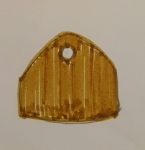
“Oh that. It is from the robot set I got for my birthday. It has been missing for a long time. Thank you for finding it!” replied Charles, whose home they were in.
“Look!” Annie exclaimed. “I can see a scene in it! There is an island and there are trees all around!”
Before anyone could react, the four friends found themselves spinning and all of a sudden, they were on an island! “This island looks exactly the same as what I saw in that shiny thing!” Annie was totally bewildered as she stared into the device she was still holding on to.
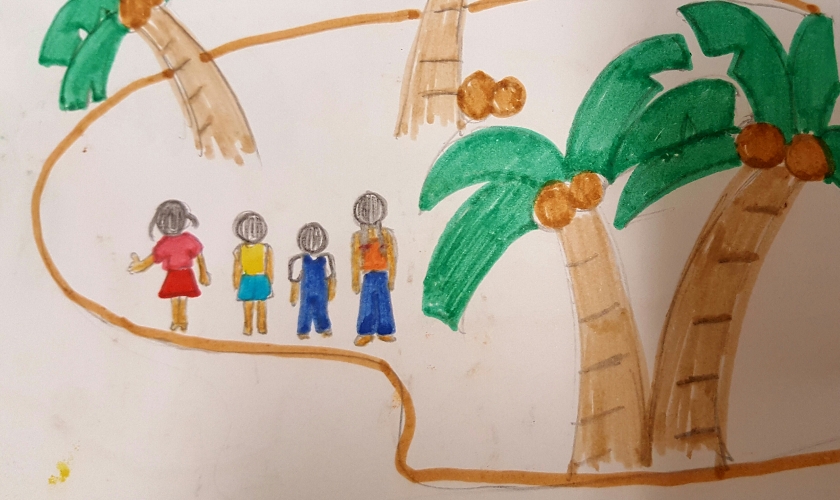 Out of nowhere, chanting was heard. “Hugalaga, hugalaga.” This was followed by a loud shriek, “Ah! Not like that!”
Out of nowhere, chanting was heard. “Hugalaga, hugalaga.” This was followed by a loud shriek, “Ah! Not like that!”
Charles and his friends ran towards the sounds. They saw cavemen of every size – tall, skinny, short, obese and more. They all looked grumpy and exhausted. A scrawny cavewoman, apparently the one who screamed, was looking as though she was about to explode.
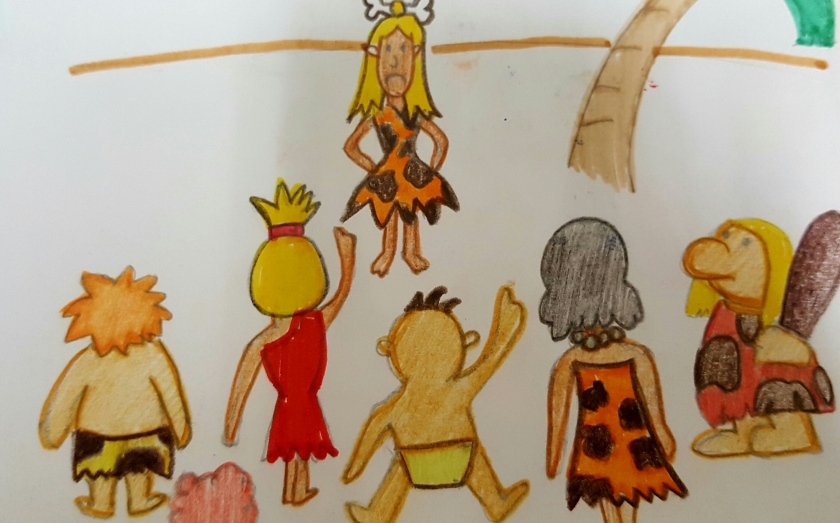
“What’s the problem?” David asked.
Glaring at David, the cavewoman replied, “I have been trying to teach them a simple dance since morning and they just cannot get it. The dance is for the celebration of our chief’s birthday this Saturday. I am exasperated!”
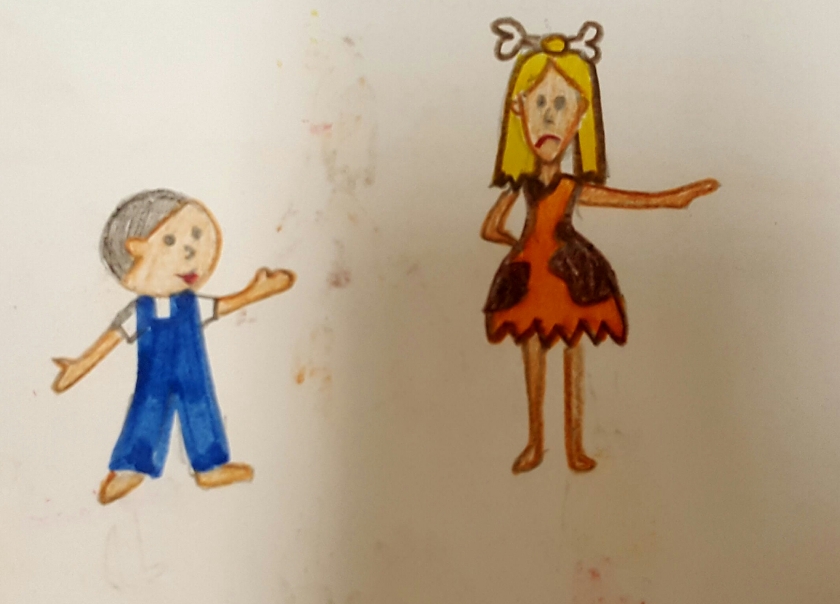
David went up to her and said, “Maybe we can help.” Charles, Annie and Belle also assured her that they were willing to help.
“Perhaps you can show us your dance steps,” suggested Belle. “By the way, I am Belle. What is your name?”
The cavewoman, who looked much calmer then, said, “I’m Roga. Happy to meet you.”
After the pleasantries, Roga showed them her dance steps. “Step, click, clap, jump, lift right arm, lift left arm, walk to the right, walk to the left, skip, clap, skip, clap, turn around….”
“That’s complicated,” Annie frowned. “Why don’t we break the steps down into patterns?”
Charles agreed. “Good idea, Annie! Let’s try it! The first two steps were step and click. We can do ‘Step, step, click, click’. How about repeating this set four times before going on to the next pattern?”
The four friends got into a straight line and did what Charles had proposed.
Step, step, click, click,
Step, step, click, click,
Step, step, click, click,
Step, step, click, click.
“We did it!” they yelled excitedly.
“I don’t see why that is a pattern,” Roga said.
“It’s easy. Look! There are four sets in this pattern. Each set is made up of ‘step, step, click, click’. The set is repeated four times,” explained Charles.
“I see! Let’s try teaching this to the other cave people,” Roga rubbed her hands eagerly. “People, shall we try the dance again? These kids have made things easier.”
[Get the pupils to dance.]
Soon, every caveman could do the first pattern. Roga looked pleased. “We can’t do ‘step, step, click, click’ forever though. Can you think of new dance steps?”
“Sure,” Charles smiled. He enjoyed music and was good with rhythms. “We could use your dance steps. I remembered you did clap, jump, lift right arm, lift left arm next. We could use this in the next pattern. Let’s also do it four times!”
[Get the pupils to dance.]
After the children had tried the new steps successfully, Roga turned to her comrades and showed them the moves. Once again, they managed to learn the dance steps very quickly. Feeling encouraged, Roga and the four children created more sets of patterns. Soon, everyone had learnt the entire dance. They chanted “Hugalaga, hugalaga” as they danced. They looked coordinated and seemed all ready to perform at the celebration. Roga praised the cavemen before dismissing them.
“Must there always be four actions in a pattern?” Roga asked, turning back to her four new friends.
“Not necessarily. There can be any number of actions, as long as the sets are repeated. Patterns can also be made using shapes. In fact, there are even patterns that occur daily, like the rising and setting of the sun,” Annie quoted her teacher. “Maybe we can show you more patterns.”
Alice picked up a branch from the ground and drew some shapes on the sandy ground.

“Can you spot the sets?” asked Annie.
“I see it. Each set consists of a triangle, a circle and a square,” Roga smiled. She took another branch and grouped each set.

“Excellent!” encouraged David. “What about this one?” He drew another pattern on the ground.

“Oh! This one is not as easy. It looks like a square and a circle forms a set, but ‘square, circle’ is not immediately repeated. So, each set consists of ‘square, circle, circle, square’!” Roga excitedly said. She grouped the sets promptly.

“The third set is not complete. If we were to continue, the next shape would be a circle,” chipped in Belle.
The children then suggested thinking of more patterns that occurred daily.
“We take breakfast, lunch, then dinner every day. Breakfast, lunch, dinner, breakfast, lunch, dinner. That’s a pattern too,” said Annie.
[Pupils to think of more patterns that occur in real life.]
“Wow! That was really great, but I think we have to go. Mum has prepared dinner for all of us. She will be worried if she finds us missing,” Charles spoke. “It was a pleasure meeting you, Roga.”
Roga grinned widely and said, “I am so glad you came. I’ve learnt something new and my friends have finally learnt the dance. Please do come again. Join us for the celebration this Saturday if you can.”
The children hugged Roga. Suddenly, Belle looked uncertain. “How do we return home?”
“Where’s the shiny device?” Charles asked. Annie took the device out from her pocket and looked into it. “I see your home, Charles.” As she said that, the four children were whisked into the air. They found themselves sitting in Charles’ bedroom. The Monopoly board was where they had left it.
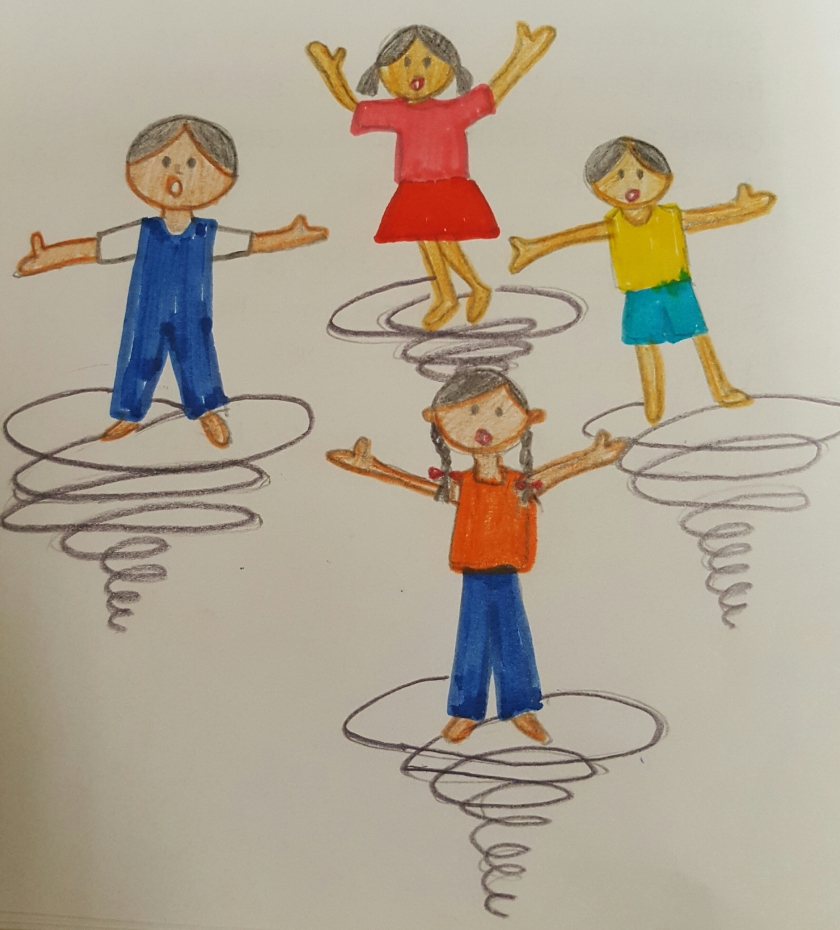
“That was truly an adventure. Please keep the shiny device carefully, Charles. Maybe we should give it a name. Let’s call it Roga after the cavewoman,” suggested David.
As the four children nodded in agreement, Charles’ mother announced that it was time for dinner. They trooped into the kitchen in high spirits. They could not wait for their next adventure.
